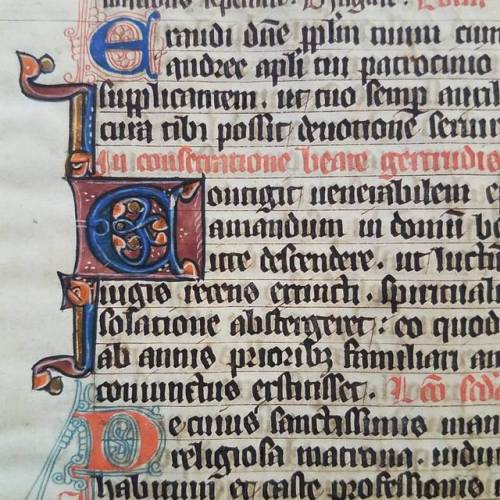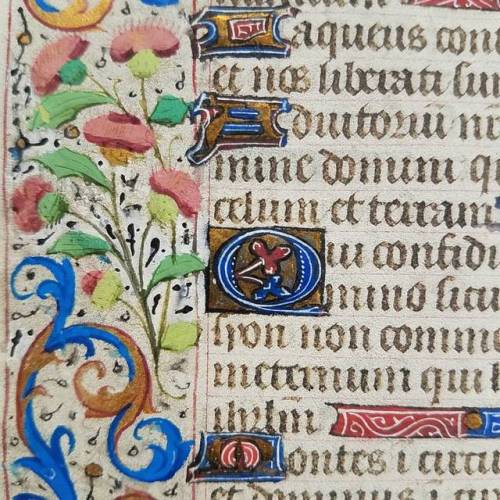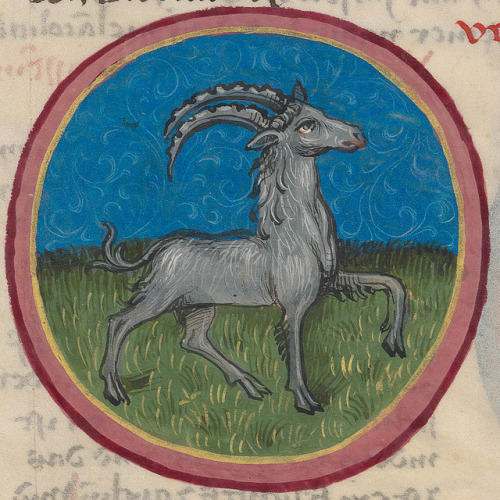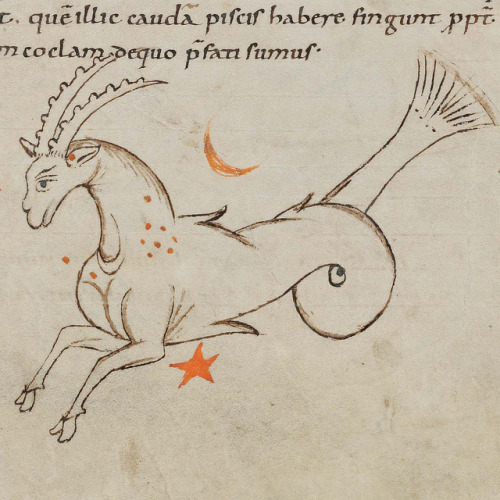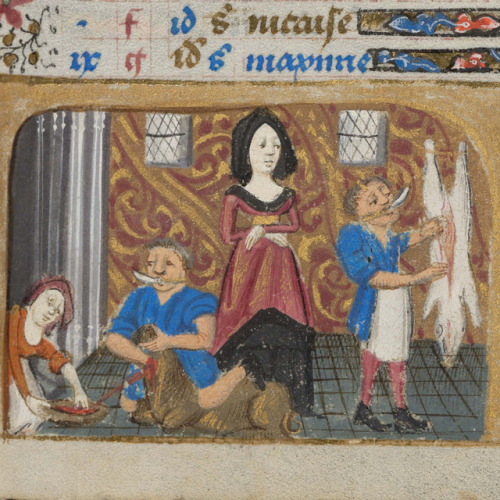#medievalmanuscript
Detail of a lovely original medieval breviary leaf.
Circa 1300, northern France or Flanders.
Litany of the Saints.
Large painted initial in blue, gold, orange and white and 5 initials with delicate pen flourishes in red and blue
$500.00
For more information and scans contact me at [email protected]
#medieval #bookofhours #manuscript #medievalmanuscript #france #oldbook #antiquebook #breviary
#art #interiordecorating #decorating #design #antique
https://www.instagram.com/p/BPYKKJHl16w/?utm_source=ig_tumblr_share&igshid=cw19ihpsqaky
Post link
Detail of an original medieval Book of Hours leaf. Likely from Flanders, 1485.
Hours of the Virgin psalms 123 & 124.
For more information and scans contact me at [email protected]
#medieval #bookofhours #manuscript #medievalmanuscript #france #oldbook #antiquebook #breviary #art
https://www.instagram.com/p/BQ06w9UlYYx/?utm_source=ig_tumblr_share&igshid=4sysabedbwwm
Post link
Our workshop is currently full, BUT we encourage visitors to stop by tomorrow to see examples from our medieval collections and make souvenir buttons!
#specialcollections #rarebooks #medieval #medievalmanuscript #champaignurbana
https://www.instagram.com/p/Cb0EzDEL8iL/?utm_medium=tumblr
Post link
Shiny! RBML recently acquired a facsimile of the Oxford Menologion – a mid-14th century prayerbook possibly from Thessaloniki. The text has a pictorial calendar of the saints for the full year, which are illustrated in 103 full-page miniatures and 2 texts in Greek.
Call number: IUQ05026
#specialcollections #rarebooks #byzantine #greek #medievalmanuscript #facsimile
https://www.instagram.com/p/CVN0XdkrXsM/?utm_medium=tumblr
Post link
Zodiac sign of CAPRICORN in a 14th century manucript on Flickr.
The zodiac sign of CAPRICORN is associated with the month of December and it is represented by the goat. In most of the standard medieval iconographic compositions, the goat is represented with two horns, standing or seated. For an animal rather familiar to the artists in that time, the portrayal of the goat tends to be surprisingly unrealistic to the extent that the goat is often shown very similar to the unicorn. Variations on this form show a creature with upper body of a goat and lower body of a fish with a tail emerging from a shell. In the modern horoscope the zodiac sign of CAPRICORN covers the period from about 22 December until 19 January. Link to the “Zodiac sign of CAPRICORN” set
Link to the “Zodiac signs” collection
Manuscript title: Roman Breviary for Sundays and feast days
Origin: Basel (Switzerland)
Period: 14th century
Image source: St. Gallen, Stiftsbibliothek, Cod. Sang. 402, p. 11 – Roman Breviary for Sundays and feast days ( www.e-codices.unifr.ch/en/csg/0402/11)
Post link
Zodiac sign of CAPRICORN in a 15th century manuscript on Flickr.
The zodiac sign of CAPRICORN is associated with the month of December and it is represented by the goat. In most of the standard medieval iconographic compositions, the goat is represented with two horns, standing or seated. For an animal rather familiar to the artists in that time, the portrayal of the goat tends to be surprisingly unrealistic to the extent that the goat is often shown very similar to the unicorn. Variations on this form show a creature with upper body of a goat and lower body of a fish with a tail emerging from a shell. In the modern horoscope the zodiac sign of CAPRICORN covers the period from about 22 December until 19 January. Link to the “Zodiac sign of CAPRICORN” set
Link to the “Zodiac signs” collection
Manuscript title: Codex Schürstab
Origin: Nürnberg (Germany)
Period: 15th century
Image source: Zürich, Zentralbibliothek, Ms. C 54, p. 23r – Codex Schürstab ( www.e-codices.unifr.ch/en/zbz/C0054/23r)
Post link
Zodiac sign of CAPRICORN in a 9th century manuscript on Flickr.
The zodiac sign of CAPRICORN is associated with the month of December and it is represented by the goat. In most of the standard medieval iconographic compositions, the goat is represented with two horns, standing or seated. For an animal rather familiar to the artists in that time, the portrayal of the goat tends to be surprisingly unrealistic to the extent that the goat is often shown very similar to the unicorn. Variations on this form show a creature with upper body of a goat and lower body of a fish with a tail emerging from a shell. In the modern horoscope the zodiac sign of CAPRICORN covers the period from about 22 December until 19 January. Link to the “Zodiac sign of CAPRICORN” set
Link to the “Zodiac signs” collection
Manuscript title: Astronomical-computistic encyclopedia
Origin: St. Gallen (Switzerland)
Period: 9th century
Image source: St. Gallen, Stiftsbibliothek, Cod. Sang. 250, p. 497 – Astronomical-computistic encyclopedia ( www.e-codices.unifr.ch/en/csg/0250/497)
Post link
Scene from “Labors of the month December” on Flickr.
DECEMBER Labors of the month December are generally associated with killing of animals for the winter. The scene usually shows one man who stands over a boar or an oxen with a hatchet. Being that every part of the animal was used, often the dead animal is shown as opposed to the killing, and the carving is the labor. Sometimes the scene shows draining of the animal blood in a bowl, usually done by a woman, whilst the man stands over it with sharpened knifes.
Link to “Labors of the month December” set Manuscript title: Book of Hours
Origin: Nantes ? (France)
Period: 15th century
Image source: Genève, Bibliothèque de Genève, Ms. lat. 33, p. 12r – Book of Hours ( www.e-codices.unifr.ch/en/bge/lat0033/12r)
Post link
This post was written by Charlie Taylor, a recipient of an Archival Scholar Research Award for the 2021 Spring Semester.
As part of my ASRA research, I’ve explored medieval illuminated manuscripts commissioned by queens of France, including this volume commissioned by Blanche of Castile. Blanche’s husband, Louis VIII of France, died when his heir was just 12 years old, and Blanche served as regent until Louis IX was old enough to take the throne. During her regency, which lasted from 1226 to 1234, she commissioned the Biblia de San Luis. The book is structured as a Bible moralisée, or moralized bible, intended to educate a young Louis on Christian doctrine and proper kingship.
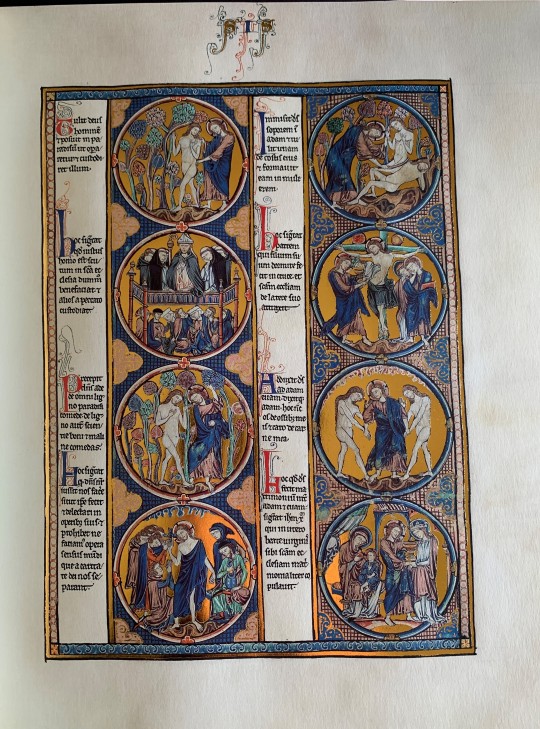
(Above) Excerpt from 2001 reproduction of Biblia de San Luis.
The page pictured above comes from a facsimile — a close reproduction made for scholarly purposes — of the Biblia de San Luisin Pitt’s Frick Fine Arts Library. The page contains two columns of text accompanied by illustrations, some of which depict scenes from the book of Genesis: at top left, God strolls with Adam in the Garden of Eden; at top right, God removes a rib from Adam to create Eve.
However, not every illustration shows a scene from Genesis. If we look again at the top right, immediately below the creation of Eve, we see Christ on the cross, with a figure emerging from a wound in his chest. What is Jesus doing in the book of Genesis? Why does explicitly Christian imagery appear on this page, when the life of Christ occurred centuries after the Hebrew Bible was written? Why does God have a cruciform halo — a halo containing the image of a cross?
Bibles moralisées don’t contain the entire text of the bible front to back; rather, they take stories from the bible and provide commentary on them, explaining their relationship to Christian doctrine. In the Biblia de San Luis, each roundel forms a pair with the one immediately below it, with the first scene taken from the bible and the second offering commentary.
It is important to note that the commentary in this bible represents a Christian-centric worldview and often dismisses Jewish readings of the text. TheBiblia de San Luis treats the events of the Hebrew Bible as natural precursors to the events of the Christian Bible. Typology, as a form of commentary, takes certain events to foreshadow other events; this book asserts a typology in the creation of Eve and the creation of the Christian Church. In the second roundel, Ecclesia, a personification of the Church, emerges from Christ’s chest. The accompanying text explains that the scene from Genesis, in which God puts Adam to sleep and makes Eve from his rib, signifies God putting Christ to rest on the cross and pulling the Church from his side. Here, Christian doctrine (and the Church as an institution) becomes central to understanding the book of Genesis, pushing the story’s Jewish origins to the margins.
Works cited
William of Auvernge and Ramón Gonzálvez Ruiz. Biblia de San Luis. Barcelona: M. Moleiro, 2001.
Ferrante, Joan. “Blanche of Castile, Queen of France.” Epistolae, 2014. https://epistolae.ctl.columbia.edu/woman/77.html.
Gerbert of Aurillac (Sylvester II) Isagoge geometriae (Introduction to Geometry) Northern Austria (Saint Lambrecht?), mid-12th c., with late 15th- or early 16th-c. humanist annotations University of Pennsylvania, Lawrence J. Schoenberg Collection, LJS 194 Gerbert of Aurillac (ca. 945–1003) was the first Frenchman elected to the papacy; he reigned as Sylvester II for the final four years of his life. His renown, however, stems from his prowess as a mathematician and pedagogue. Among his achievements were the reintroduction of the abacus and armillary sphere to Western Europe, via the Islamic civilization of Al-Andalus.
Post link

